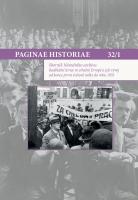Srovnání postavení sociální demokracie a komunistů v rakouském politickém systému (1918–1934)
The Comparison of the Position of Social Democrats and Communists in the Austrian Political System (1918–1934)
Author(s): Miroslav ŠeptákSubject(s): History, Political history, Recent History (1900 till today), Interwar Period (1920 - 1939), History of Communism
Published by: Národní archiv
Keywords: Austria 1918-1938; communism; political parties
Summary/Abstract: The study focuses on the comparison of the position of social democrats and communists in the Austrian political system in the years 1918–1934 from the aspect of the leader, inner unity, organisational structure, and selected election results at the federal and provincial levels. While the social democrats had several prominent personages including Karl Renner, Karl Seitz, Otto Bauer, and Robert Danneberg, the communists failed to find a suitable leader throughout the given period. Even the long-term functionary Johann Koplenig was an unsuccessful applicant. Unlike the communists, the social democrats outwardly presented themselves as an internally unified party successfully harmonising their inner disputes. Toward the end of the 1920s, every sixth adult inhabitant of Austria was a member of the Social Democratic Workers’ Party of Austria (SDAPÖ). The communists reached a record number of members at the turn of May and June 1919. After they failed to implement the vision of the radical restructuring of the economy and society, their membership base rapidly decreased. The party was rather an association of small groups conducting legal and illegal activities. Similarly, the election results at the federal and provincial levels favoured social democracy. In all parliamentary elections, the SDAPÖ was the main rival of the Christian Social Party. The Communist Party of Austria (KPÖ) never gained the parliamentary relevance at the federal or provincial level. A closer look at the election results in the federal states reveals but one accord between the social democrats and communists. Vienna was the ‘bastion’ of both. It was not until the Austrian parliamentary system was transformed into an authoritarian regime that it brought social democracy and the communists on the same platform. Their resistance against the state security units and the Heimwehr authoritarian movement culminated in a definite defeat in February 1934. The social democrats then had to take on the previous communist path, working illegally. Compared to the KPÖ, they coped with significant difficulties.
Journal: Paginae Historiae
- Issue Year: 32/2024
- Issue No: 1
- Page Range: 35-46
- Page Count: 12
- Language: Czech

